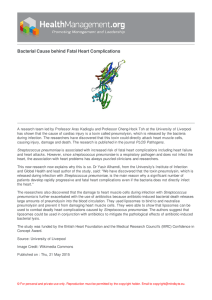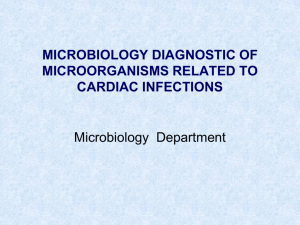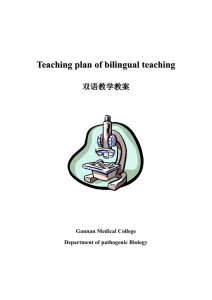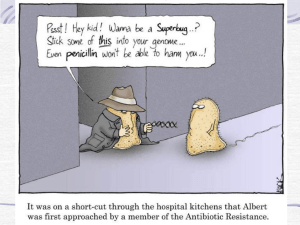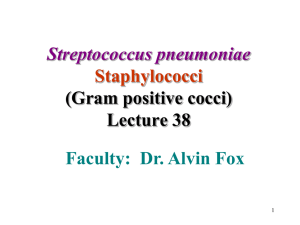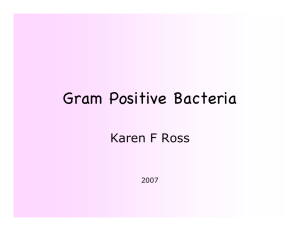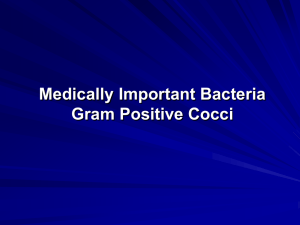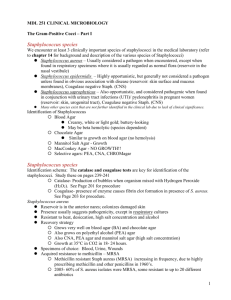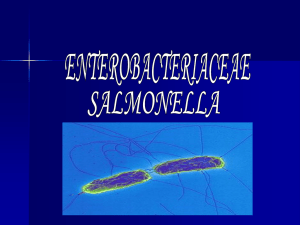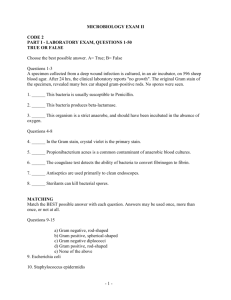Streptococcus pneumoniae
advertisement
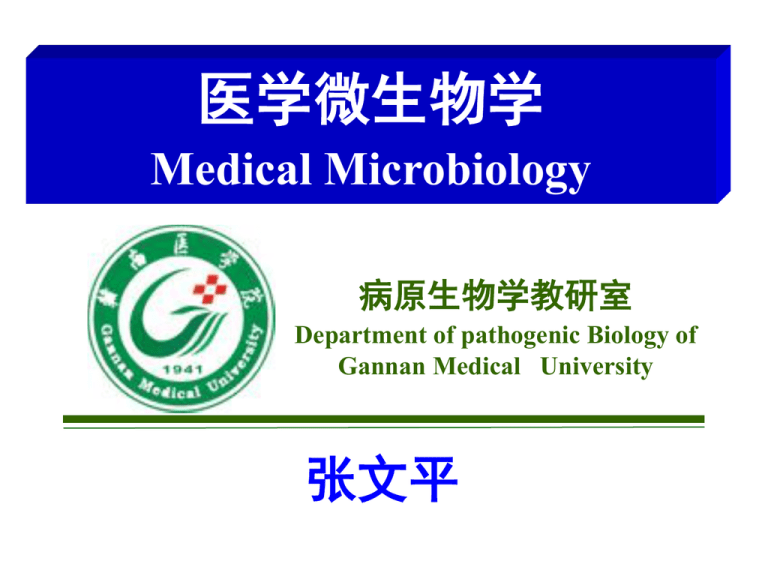
医学微生物学 Medical Microbiology 病原生物学教研室 Department of pathogenic Biology of Gannan Medical University 张文平 Chapter 10 Pyogenic bacterium Pyogenic cocci化脓性球菌 Gram-positive cocci Staphylococcus aureus 金黄色葡萄球菌 Streptococcus pyogenes 化脓性链球菌 Streptococcus pneumoniae 肺炎链球菌 Gram-negative cocci Neisseria meningitides Neisseria gonorrhoeae 脑膜炎奈瑟菌 淋病奈瑟菌 Pyogenic bacillus化脓性杆菌 Gram-negative bacillus Pseudomonas aeruginosa铜绿假单胞菌 Escherichia coli大肠埃希菌属 Proteus 变形杆菌 Staphylococcus 葡萄球菌 Biological character I. morphology II. culture III.Biochemical tests IV. typing morphology G+, mainly arranged in grape-like clusters Gram staining Culture Individual colonies are circular, 2-3mm in diameter with a smooth, shiny surface;appear opaque and are often pigmented Staph. aureus Blood agar plate Golden-yellow pathogenic Staph. epidermidis Staph. saprophyticus white fawn opportunists opportunists Colonies of Staph. Aureus and Staph. epidermidis Important properties All staphylococci produce catalase(触酶) H2O2 →O2 + H2O S aureus coagulase Mannitol fermentation staphylococcus A protein ,SPA Binds to the Fc portion of IgG at the complement-binding site Significance Preventing the activation of complement anti-phagocytic coagglutination resistance Resistant to dry, heat , salt Pathogenesis Virulence factors LTA Invasive enzyme : coagulase toxin:lysin(αβγ ) leucocidin epidermolytic toxins enterotoxins TSST-1 Enterotoxin 肠毒素 Cause vomiting and watery, nonbloody diarrhea Superantigen Heat-resistant 100℃ 30min Toxic shock syndrome toxin 1 毒素休克综合征毒素-1 Cause toxic shock • Tampon–using menstruating women • Individuals wit h wound infection • Patients with nasal packing used to stop bleeding from the nose superantigen Exfoliatin 表皮剥脱毒素 (epidermolytic toxins) Cause scalded-skin syndrome in young children Acts as protease(蛋白酶) that cleaves desmosome(桥粒),leading to the separation of the epidermis at the granular cell layer coagulases Free coagulase Converts fibrinogen in citrated plasma into fibrin Bound coagulase reacts with fibrinogen to inhibit the phagocytosis of macrophages and damage of bactericide substances in humor by coating the organisms with fibrin infections 1) purulent infection (1). local infection skin infection: hair folliculitis; boil(疖); carbuncle(痈); impetigo(脓疱病). (think pus; limited local area) (2).organ infection: pneumonia; meningitis(脑膜炎) Infections (3).Systemic infection: Septicemia; pyemia 2) Toxin diseases (1). Food poisoning (enterotoxin) (2). TSS(Toxic shock syndrome) (3). SSSS(staphylococcal scalded skin syndrome): 3) Staphylococcal enteritis (ii) Food poisoning. • The food becomes contaminated with the organism from human contact, grows and produces enterotoxin. • The organism does not "infect" on ingestion of food. • Onset and recovery both occur within a few hours. • Vomiting, nausea, diarrhea and abdominal pain are present. (v) Toxic shock syndrome particularly after tampon use includes: • fever • rash(皮疹) • desquamation(脱屑) • vomiting • diarrhea Toxic shock toxin is involved. The organism does not disseminate. However, the toxin does and is responsible for the clinical features. Laboratory diagnosis specimen: *pus * sputum (low respiratory tract infection) * blood (septic shock, osteomyelitis, endocarditis) * food/faeces or vomit (food poisoning) * mid-stream urine (pyelonephritis 肾盂肾炎 or cystitis膀胱炎) Laboratory diagnosis *direct smear :gram stain *isolation and identification: blood agar *coagulase test *Enterotoxin test and animal test *Mannitol fermentation streptococcus 链球菌 streptococcus Biological character G+,arranged in chains of varying length culture Blood agar plate α-hemolytic streptococci β-hemolytic streptococci γ- streptococci polysaccharide groups M antigen Surface protein antigen R S T Classsification: (1).Hemolytic activity: -hemolytic streptococcus Incomplete hemolysis, green zone around colonies *Opportunistic pathogens -hemolytic/pyogenic streptococcus Complete hemolysis, clear zone around colonies *major human pathogens -streptococcus No hemolyzation, no pathogenicity. Classification of -hemolytic streptococcus Antigenic structure: Polysaccharide antigen (group-specific antigen). 19 groups Group A streptococci are main human pathogens protein antigen (type-specific antigen). M protein: *presents in cell wall (group A) *Anti-phagocytosis *adhere to epithelial cells *clump platelet and leukocyte *heat stable; acid stable (pH 2) pathogenesis Invasive enzyme Virulance factors Hyaluronidas streptokinase DNAases LTA attachment toxin M protein Streptolysin (O,S) Pyrogenic exotoxin (scarlet fever toxin) (1).Invasiveness (i).surface structure *LTA(lipoteichoic acid): adhere to sensitive cell (epithelial cell; platelet; RBC; WBC; lymphocyte; mucous membranes) * M-protein : ◆anti-phagocytotic ◆Common antigen---heart muscle cell (rheumatic fever) 风湿热 ◆M-Ag Ab hypersensitivity(glomerulonephritis) 肾小球肾炎 (ii).enzyme *Hyaluronidase (spreading factor): Splits hyaluronic acids bacteria spread * Streptokinase (SK): Lyse fibrin, prevent plasma clotting bacteria spread * Streptodornase (SD): Resolve DNA bacteria spread (2).Toxins---exotoxin (i) Streptolysin (hemolysin) StreptolysinO(SLO) oxygen-labile hemolysin O2 (-SH-------S-S-) antigenicity-----ASO (antistreptolysin O) destroy WBC, pletelet virulence of MΦ, N.C Streptolysin S(SLS) oxygen stable O2 (-SH------SH) weak antigen destroy WBC virulence of many tissues ( ⅱ ) Erythrogenic toxin (or pyrogenic toxin /scarlet fever toxin) produced by most strains of group A streptococci cause scarlet fever possess antigenicity, antitoxin specifically neutralize the toxin protien heat stable Diseases of streptococcal infection 1 ) . Infections of group A -hemolytic streptococci (1). local purulent infections: *pharyngitis,咽炎 *erysipelas 丹毒 *puerperal fever 产褥热 (2). systemic infection : * septicemia *scarlet fever (3). poststerptococcal diseases (hypersensitive disease) (i) acute glomerulonephritis ( group A) mechanism: *type III hypersensitivity (most) M protein-Ab immune complex *type II hypersensitivity common Ag deposition glomerular basement cross reacts with glomerular Membrane basement membrane activation C3,C5 tissue destruction tissue destruction (ii) Rheumatic fever (many types of group A streptococci) mechanism: *immune complex (deposition) heart, joints type III hypersensitivity *common Ag crossreactionheart type II hypersensitivity Clinical diagnosis Gram stain based on cultures from clinical specimens ASO Serologic methods Normal titer 1:400 Acute glomerulonephritis and acute rheumatic fever. Prevention & treatment *Treat the pharyngitis and tonsillitis in time, avoid the post streptococcal diseases. *Antibiotics and chemical agents: penicillin G for the first choice Streptococcus pneumoniae Streptococcus pneumoniae S. pneumoniae is a leading cause of pneumonia in all ages (particularly the young and old), often after "damage" to the upper respiratory tract (e.g. following viral infection). It also causes middle ear infections (otitis media). The organism often spreads causing bacteremia and meningitis. S. pneumoniae is α-hemolytic and there is no group antigen. Direct Gram staining or detection of capsular antigen in sputum can be diagnostic. The organism grows well on sheep blood agar. Autolysin Pneumococci are identified by solubility in bile. An autolysin (peptidoglycan degrading enzyme) is released by bile from the cell membrane and binds to a choline-containing teichoic acid attached to the peptidoglycan. The autolysin then digests the bacterial cell wall resulting in lysis of the cell. The optochin test is a presumptive test that is used to identify strains of Streptococcus pneumoniae. Optochin disks are placed on inoculated blood agar plates. Because S. pneumoniae is not optochin resistant, a zone of inhibition will develop around the disk where the bacteria have been lysed. This zone is typically 14mm from the disk or greater. Not optochin sensitive optochin sensitive Capsule This is highly prominent in virulent strains and its carbohydrate antigens vary greatly in structure among strains. The capsule is anti-phagocytic and immunization is primarily against the capsule. Capsular vaccines are available for susceptible individuals; immunity is serotype-specific. Neisseria Gram negative cocci, usually arranged in pairs. Some are normal inhabitants in respiratory tract. Others are human pathogens (eg: gonococcus,meningococcus ) … Common biological characteristics 1.Gram negative cocci, kidney-shaped, in pairs have capsules and pili 2.Need enriched medium (chocolate blood agar ) 3. 5~10%CO2 4.Resistance: very weak “fragile”, extremely sensitive to drying, heat, cold Neisseria meningitidis 脑膜炎奈氏菌 Meningococci and their colonies Pathogenicity and immunity 1. Pathogenicity: (1) Human is the only natural host for pathogenic meningococci. Child: susceptible (lacking specific Abs) (2) virulence factor: *Pili– attach to nasopharyngeal mucosa *capsule – antiphagocytosis *endotoxin – main pathogenic substance capillary tube, small blood vessel 2.Pathogenesis: epidemic cerebrospinal meningitis 流行性脑脊髓膜炎 clinical typing: common, outbreak, septicemic type Clinical cause: 3 stages (1)Organisms nasoparynx ( nasopharyngeal infection : asymptomatic , most are carriers, only 2~3% go to next stage ) (2) blood stream <fever, skin ecchymosis > cross the brain barrier <severe headache ,vomitting, stiff neck > (meningococcemia. bacteremia or septicemia. blood contain cocci ) (3)meninges (meningitis. meninges pyogenic inflammation. spinal fluid contain cocci ) Immunity: group-specific antibody, cross-immunity between groups. III. Laboratory diagnosis 1. specimen: spinal fluid, blood, nasopharyngeal swabs . (*note: “fragile” bed-side inoculation) 2. direct smear : smear Gram stain (G- diplococci, within white cells) 3. isolation and identification: specimen serum broth chocolate blood agar plate (5~10% CO2 ,37C ) Gram stain and biochemical, serological identification 4. serologic test : to detect the unknown Ag with given Ab Prevention and treatment 1. Polysaccharide vaccine (group A, C) 2.Penicillin;cefotaxime; chloramphenicol Neisseria gonorrhoeae Gonococci and their colonies 1. Pathogenic factors * Pilli: attach to epithelial cells (urinarygentital, RBC) * IgA 1-protease: break down surface IgA antibodies. *Outer membrane protein (OMP): Diseases: *Gonorrhea (STD: sexually transmitted disease) acute urethritis尿道炎(male); pelvic inflammatory 盆 腔 炎 (female) *Ophthalmia neonatorum→blindness 新生儿眼结膜炎 Laboratory diagnosis Specimen: purulent secretion of genitourinary tract Isolation and identification: direct smear, culture, biochemical tests Prevention and treatment *penicillin----- Gonorrhea *silver nitrate ---neonatorum ophthalmia
